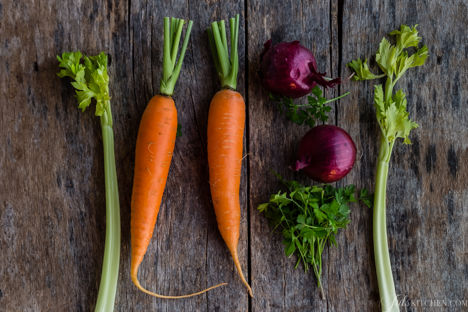
Odori, battuto, soffritto – the foundations of Italian cooking
Giulia Scarpaleggia sheds some light on the simple cornerstones of Italian cuisine.
Odori, battuto, soffritto – the foundations of Italian cooking
Giulia Scarpaleggia sheds some light on the simple cornerstones of Italian cuisine.
Odori
Let’s start with the first one, odori, which literally means 'smells'. When you go to the market and buy your fruit and vegetables, this will be the last question you’ll receive from the vendor: ‘do you want some odori?’ If you nod, they’ll tuck a carrot, a stalk of celery, a bunch of parsley, maybe some basil if it's in season and an onion into your shopping bag. They won’t charge you a penny.
These vegetables are grouped together under the name odori as they give any typical recipe a fragrant smell. They can vary from region to region, from family to family, but they will all be known under the same general name. Consider a slow-cooked, traditional, comforting beef broth. You take a large pot, fill it up with water and add your chosen cut of meat along with some odori: a carrot and a celery for good measure, then an onion, a tiny ripe tomato, a few leaves of parsley and basil; sometimes a clove, too. The odori is what gives it that special, inviting aroma.
Battuto
Let’s move on to the second word which shows an understanding of the basic principles of Italian cooking, battuto; a mix of minced vegetables and the Italian equivalent of the French mirepoix.
Many recipes start by asking you to prepare a battuto, often specifying the vegetables and herbs to use. The simplest battuto will require just the aforementioned odori: a carrot, a celery, an onion and a bunch of basil or parsley. Wash and chop them roughly, then mince on a wooden cutting board with a knife or, traditionally, a mezzaluna (a semicircular blade with a handle at each end). Many grandmothers have carved a bowl shape into their boards by using their mezzaluna day after day.
Nowadays, if you want to speed up the process, you would use a food processor to make a fine battuto. Add the hard vegetables – carrot and celery – first and leave the onion until last, otherwise you’ll be left with a watery paste. It’s a good idea to make a large batch of battuto and scoop it into small jars; it will freeze perfectly and you’ll have your secret Italian fix in the freezer when you need to make a soup. You can also take your battuto to the next level by adding cubed ham, lardo or guanciale, pounded together to make a paste.
Soffritto
Once you have your odori from the market and have prepared your battuto, it’s time to fry it in olive oil or butter to turn it into a rich soffritto. Instead of spices, Italian cuisine relies on fresh herbs, onion, garlic and olive oil to stand out. Think about pappa al pomodoro (a bread and tomato soup), bean soup, meat sauce – they wouldn’t be the same without the lightly sautéed vegetables that lend a special depth to a dish, adding flavour and richness to soups, stews and sauces.
The best example of how important a good soffritto can be is in sugo finto – which literally means ‘fake sauce’. It’s a vegetable tomato sauce which mimics a meat sauce so well that even you, who made it, will be fooled! It is an old, traditional recipe, so be sure to drizzle plenty of olive oil into your pan. Add the minced vegetables and cook on a low heat until soft and golden, then pour in half a glass of your favourite red wine and let it reduce – this will add body and character. Finish with some pureed tomatoes, which will cook slowly until the mixture becomes a thick and tasty sauce, then serve it with pasta for a perfect dish to share with friends. Now you have a basic knowledge of Italian cuisine and can choose the right vegetables to start any robust, traditional recipe.


